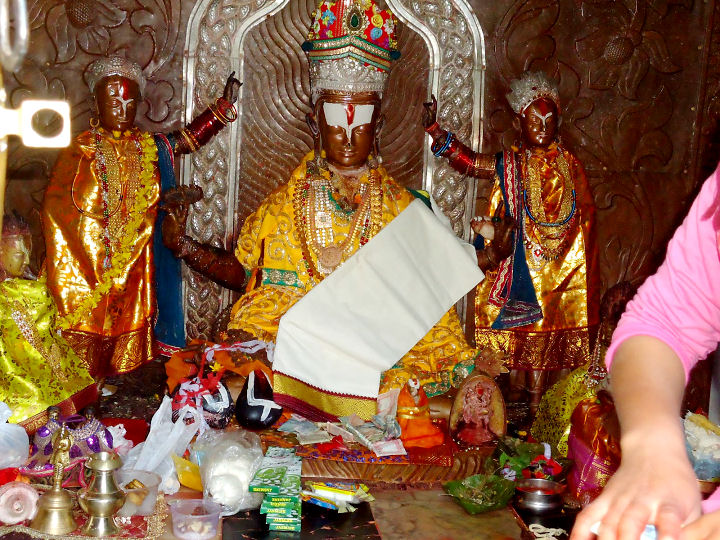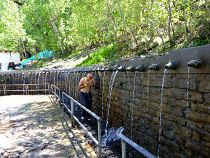
OM MANI PADME HUM |
||
ANNAPURNA CIRCUIT TREKKING - MUKTINATH Kagbeni - Tatopani - Marpha - Jomson - Muktinath Muktinath Temple - Journey to the Rooftop of the World |
||
Sri Muktinath with Laksmi (Bhumi-Devi) and Sarasvati (Sri-Devi)
Śrī Muktināth
Sri Muktinath is one of the most-visited tirthas in Nepal, revered by both Hindus and Buddhists, and the glories of Muktinath are sung in the Vishnu Purana. Located in Muktinath Valley, 140 miles from Kathmandu, the temple is situated at the foot of Thorong La mountain pass, over 12,000 feet (3,700 meters) above sea level. Mukti-kshetra, the "place of salvation", is the abode of Sri Muktinath, along with Lakshmi and Sarasvati Devi, and Garuda.
The Muktinath temple is a small, rugged structure, situated in a vastly rugged landscape overlooking the Nilgiri and Dhaulagiri Himalaya ranges. The presiding Deity, Sri Muktinath, is a beautiful murti, sitting in meditation.
The pagoda-style Muktinath Temple was consecrated in 1815 A.D by Queen Subarna Prabha, the second wife of Shah Rana Bahadur (1775-1806), King of Nepal, after she had a dream. The temple is built in the typical pagoda style of a Hindu temple in Kathmandu Valley and is dedicated to Lord "Mukti-nath", the Lord Who grants Salvation or Moksha. Only Hindus are permitted to enter the inner temple, which is also known as Mukti-Narayanan-kshetram.
In the year 2012 the roof top of the pagoda-style Temple was dismantled, renewed and renovated.
Srivaishnava's consider Muktinath to be one of the 108 Divya Desam, or principle abodes of Lord Visnu, and one of the eight most sacred abodes, or Svayam Vyakta Ksetras, the other seven being Srirangam, Srimushnam, Tirupati, Naimisharanya, Totadri, Pushkar and Badrinath.
In Buddhist tradition, Sri Muktinath Vishnu/Lokeswar is worshipped as Avalokiteshvara (Chenrezig). Before the origin of Buddhism, the ancient place name for Muktinath was Thiru Saligramam, the naturally available form of Lord Narayana. Buddhists also call it Chumig Gyatsa, or 'hundred waters', and Tibetan Buddhists consider it an important abode of the Dakinis, the goddess Sky Dancers. Muktinath is also one of the 51 Sakthi-peetams. The traditional caretakers of the place are the Muktinath Nuns.
Muktinath is a sacred place for both Hindu Pilgrims and Tibetan Buddhists at 3750 meters (12,300 feet) at the Annapurna Circuit in the Himalayas of Nepal. It is a great example of how two religions can share the same holy spot with mutual respect and support.
In the prakaram (outer courtyard) of the temple there are 108 water spouts in a semi-circle, through which sacred waters flow. The waters are representative of the pushkarini waters of all 108 Divya Desam tanks, along with Tirumala and Vaikuntha. Devotees are instructed to take holy bath by letting the waters flow over their heads, moving under all 108 spouts, one after the other. This is usually done at high speed, due to the frigid temperatures. The waterway moving downstream from Muktinath along Kali Gandaki (Kandaki River) is the famed source of shaligram-shilas.


